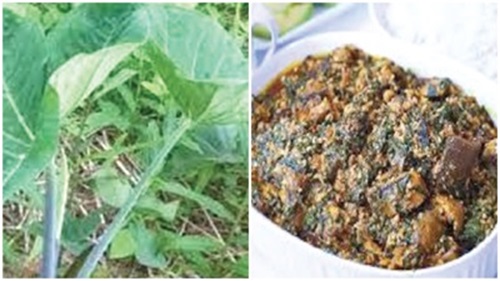The discussion regarding galamsey’s harmful effects on the environment, water sources and livelihoods is well-known.
However, recent public conversations have highlighted a troubling issue: the contamination of cocoyam and its leaves, known as ‘kontommire’.
Scientific evidence has shown that cocoyam grown in areas polluted with heavy metals contains traces of these toxic substances, raising an even more alarming concern about food safety.
Data, science
For many Ghanaians, it is the intensified media discussion that has made the “kontommire” scare seem urgent, as if it were new news.
However, research has long shown the impressive ability of cocoyam to absorb heavy metals from polluted soils.
What is currently dominating the media has been quietly circulating within the scientific and academic communities for years.
It appears the information is only now reaching the wider public, causing widespread concern over a problem that experts have been aware of for quite some time.
Nonetheless, this delayed awareness is not necessarily a disadvantage.
Scientific discoveries often stay within academic circles for years before they become part of mainstream discussion, and that is exactly why articles like this are important.
Again, much of the ongoing discussion has been qualitative—based on fears, guesses and general warnings about contamination.
While this has helped draw public attention, it does not answer the key question: what does the data and science really say?
To truly understand the seriousness of the situation, we need to look beyond perceptions and examine the scientific measurements that show how much arsenic, mercury, cadmium and other heavy metals are being absorbed into cocoyam and, ultimately, onto our dinner plates.
Only by facing this hard evidence can we fully understand the true nature of what we are consuming.
I present the following abstracts of two of such empirical studies from a team of researchers (Margaret Ekua Amosah, Deborah Asarebea Asare, Eugenia Anderson, Grace Ofori-Sarpong Akuffo) from the University of Mines and Technology, Tarkwa: Assessing the Toxicity of Colocasia esculenta (Cocoyam Plant) Grown on Mercury Contaminated Soil, December 2021.
Problem
The unsafe disposal of heavy metals is a serious environmental problem all over the world, as it has devastating effects on plant biodiversity, as well as animal and human health.
Contamination can be caused by effluents from industries and exposure to rocks containing metalloids or heavy metals such as arsenic (As), lead (Pb) and mercury (Hg).
Several techniques have been used to clean up soil and water bodies contaminated with these heavy metals or metalloids.
Phytoremediation is one of the emerging methods that has proven to be eco-friendly and efficient.
Plants such as Colocasia esculenta have been reported to be hyperaccumulators.
However, there are concerns regarding the excessive metal uptake by the plant when grown on mercury-contaminated sites, since high Hg levels can cause toxicity in human beings.
This study was thus carried out to ascertain the toxicity of C. esculenta plants cultivated in a 10 ppm Hg-induced soil sample for four weeks.
The concentration of mercury in soil, water and cocoyam samples decreased after 28 days of planting. Accumulation of Hg in plant tissues was measured, and the Translocation Factor (TF) was calculated.
TF was in the order of Root-Stem (0.60) > Root-Leaves (0.56) > Soil-Root (0.23). The results indicated that Cocoyam plants have an excellent ability to remove Hg from contaminated soils and further accumulate it in their tissues.
With the threshold level of Hg at 0.0016 mg/kg body weight (FAO/WHO), the results obtained suggest that cocoyam plants grown in such contaminated areas may pose health threats to humans.
Investigating the Toxicity and Edibility of Cocoyam Plant (Colocasia esculenta) in an Arsenic-Contaminated Soil, May 2023.
Concern
The exposure of heavy metals such as mercury, cadmium, arsenic, chromium, thallium and lead and their interactions with soil and plants are of much concern due to their potential health effect. Phytoremediation is one method used by plants to clean up soils contaminated with these heavy metals.
Arsenic is a carcinogenic substance that thwarts plant growth and causes skin cancer in humans, among other health effects.
Although arsenic decontamination by phytoremediation has been reported, the literature is silent about the toxicity and edibility of the plant after arsenic uptake.
This study, therefore, assessed the toxicity of the Colocasia esculenta plant after using it as a phyto-sorbent for four weeks in a simulated arsenic-contaminated soil.
The Bioaccumulation Factor (BAF) and the Translocation Factor (TF), calculated after the experiment, were 1.43 and 1.60 respectively, indicating its hyper-accumulative property and high translocation of arsenic through the various parts.
There was a decreasing trend of arsenic concentration in the solution samples across the weeks, and an accumulation of 58 per cent, 28 per cent and 14 per cent of arsenic in the stem, roots and leaves of the plant, respectively.
The results showed that Colocasia esculenta is a good accumulator of arsenic from the soil.
A comparison of the different arsenic levels recorded in the plant parts, with standards, presents a great concern in consuming this plant exposed to an arsenic-contaminated environment.
However, further studies should be conducted to ascertain the bioavailable state of arsenic in the plant parts after its uptake.
The writer is a Business Development Manager,
Marketing Communications Specialist,
University of Mines and Technology, Tarkwa.
E-mail: mbremfi@umat.edu.gh

